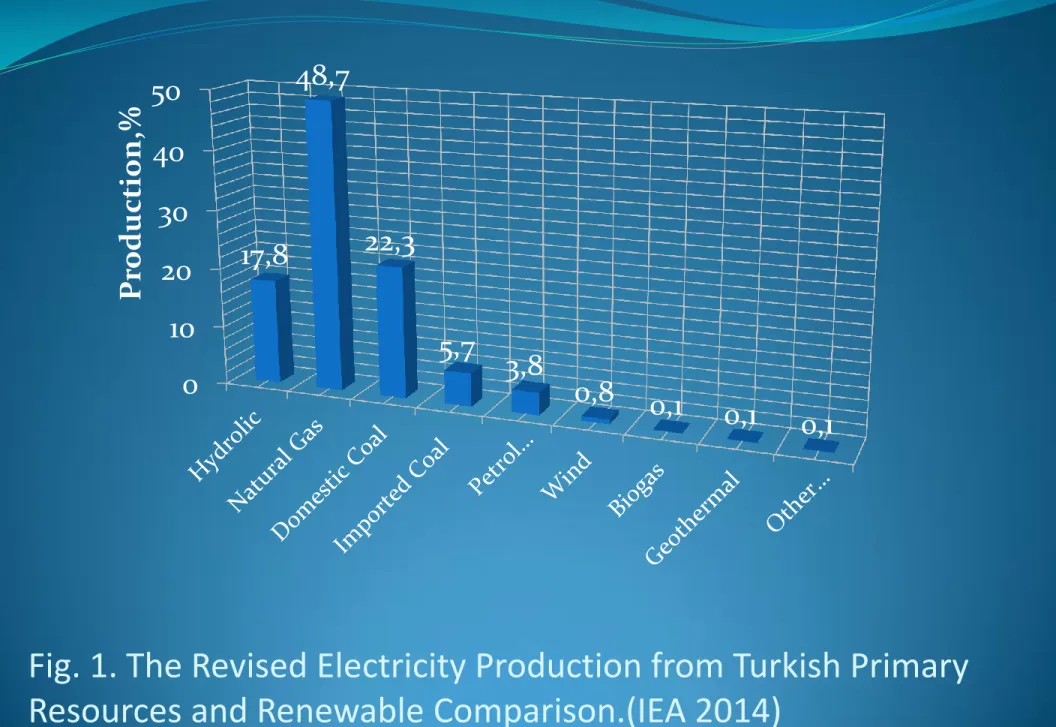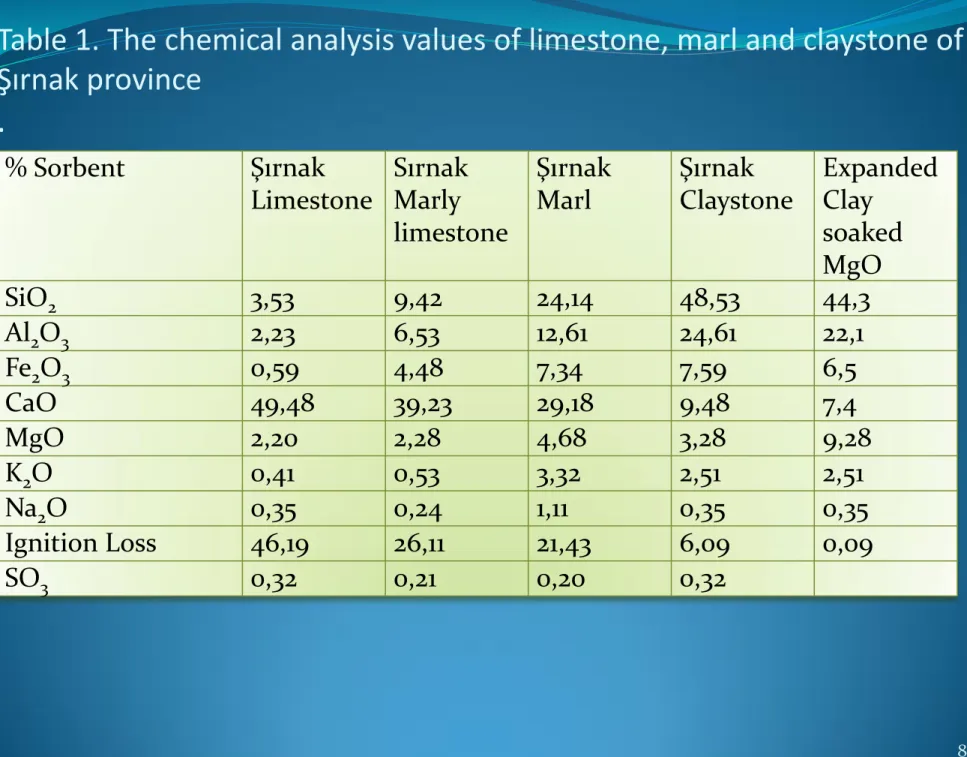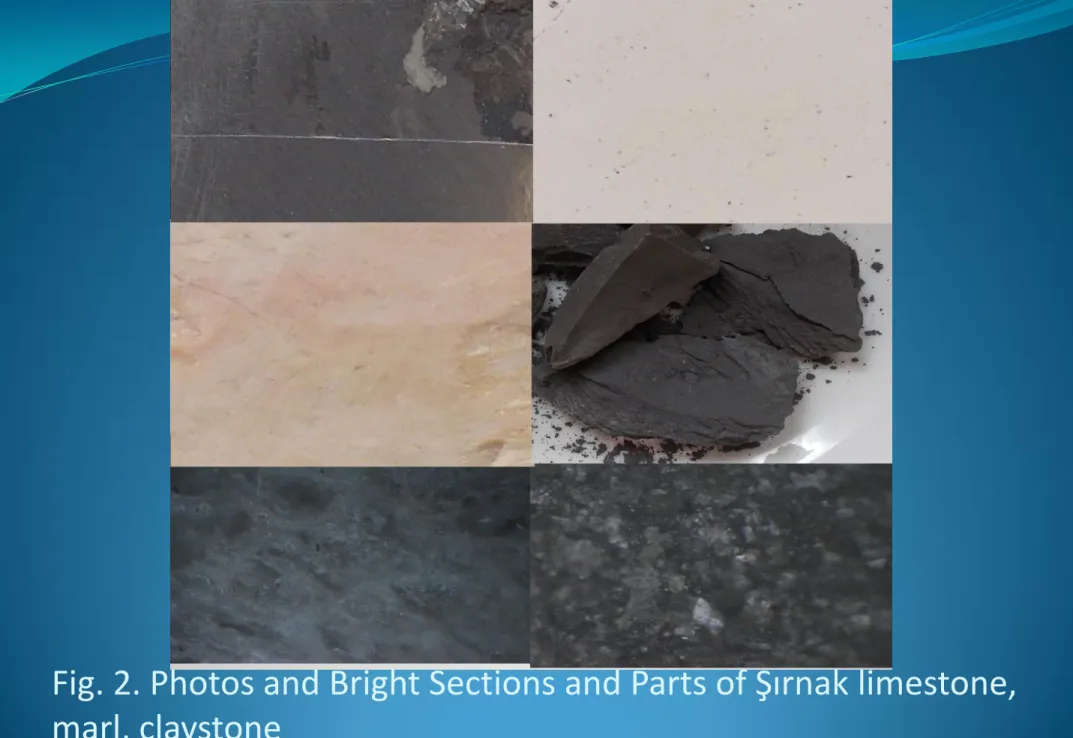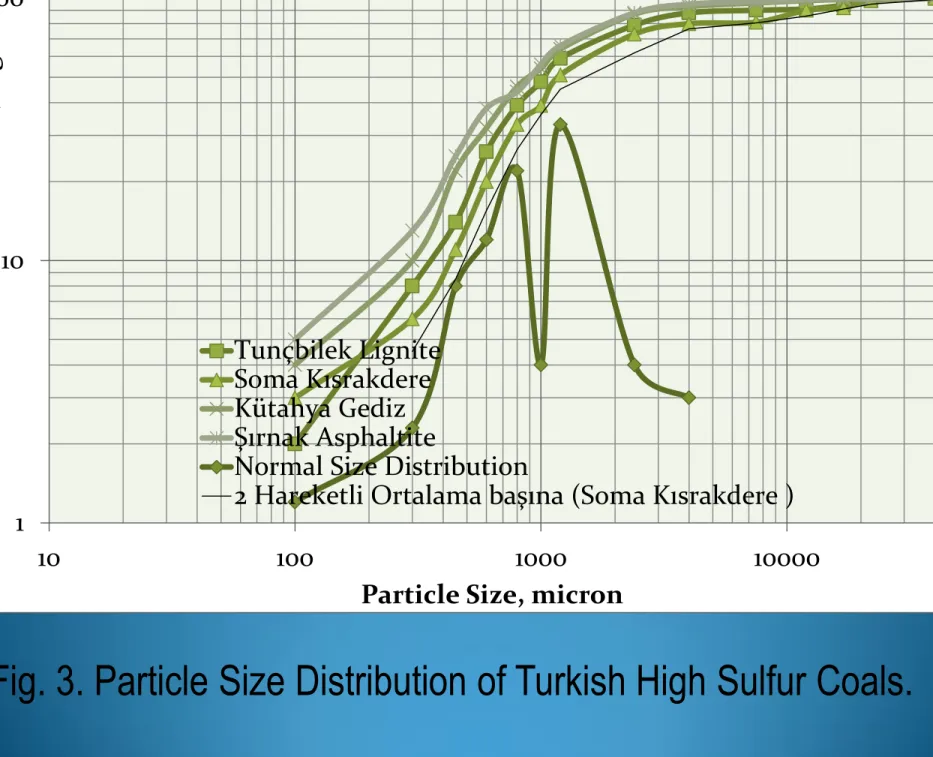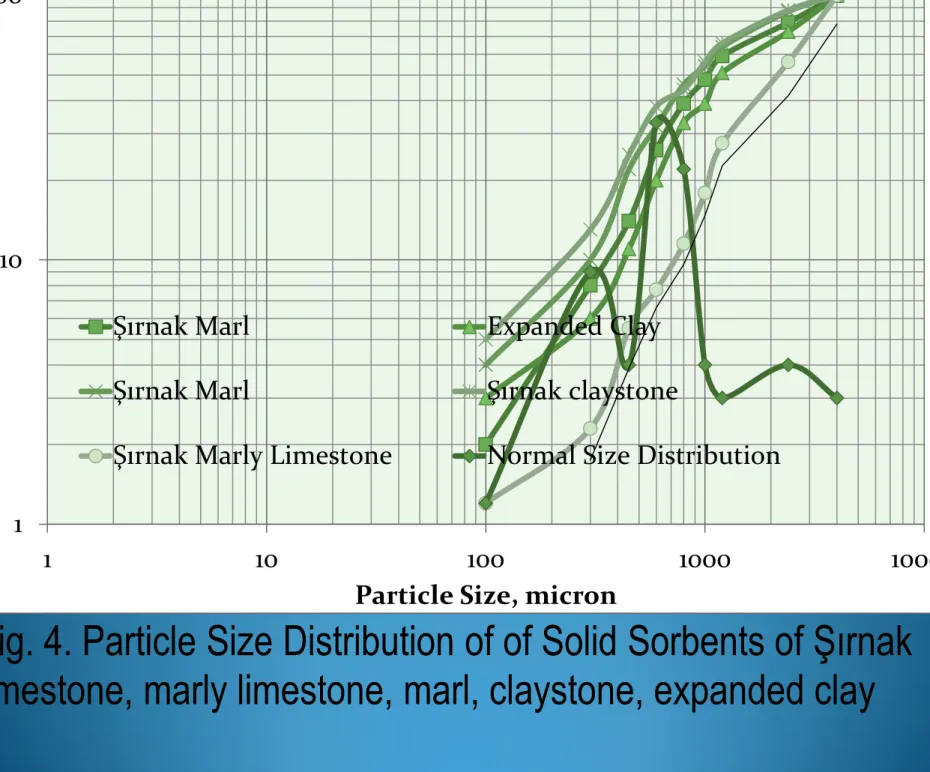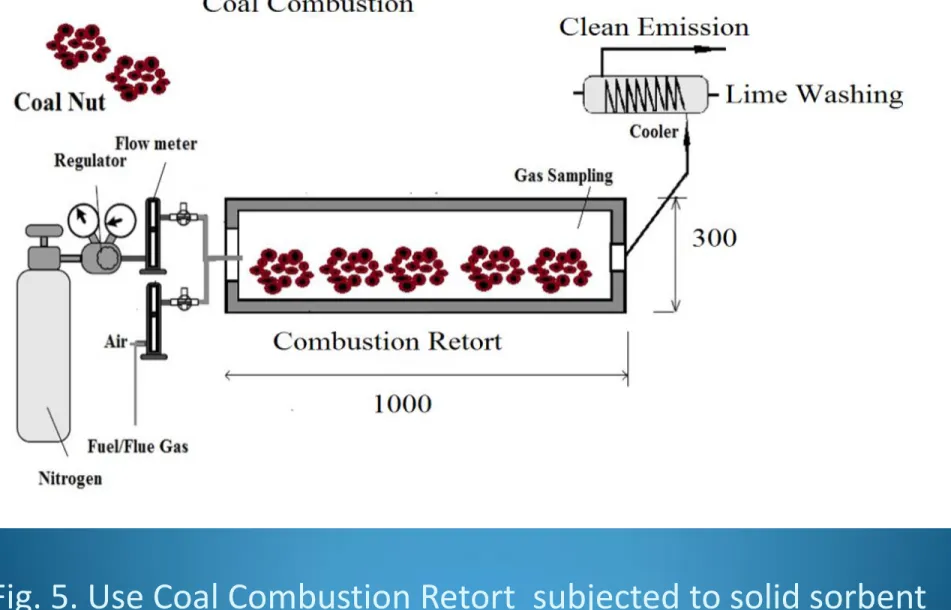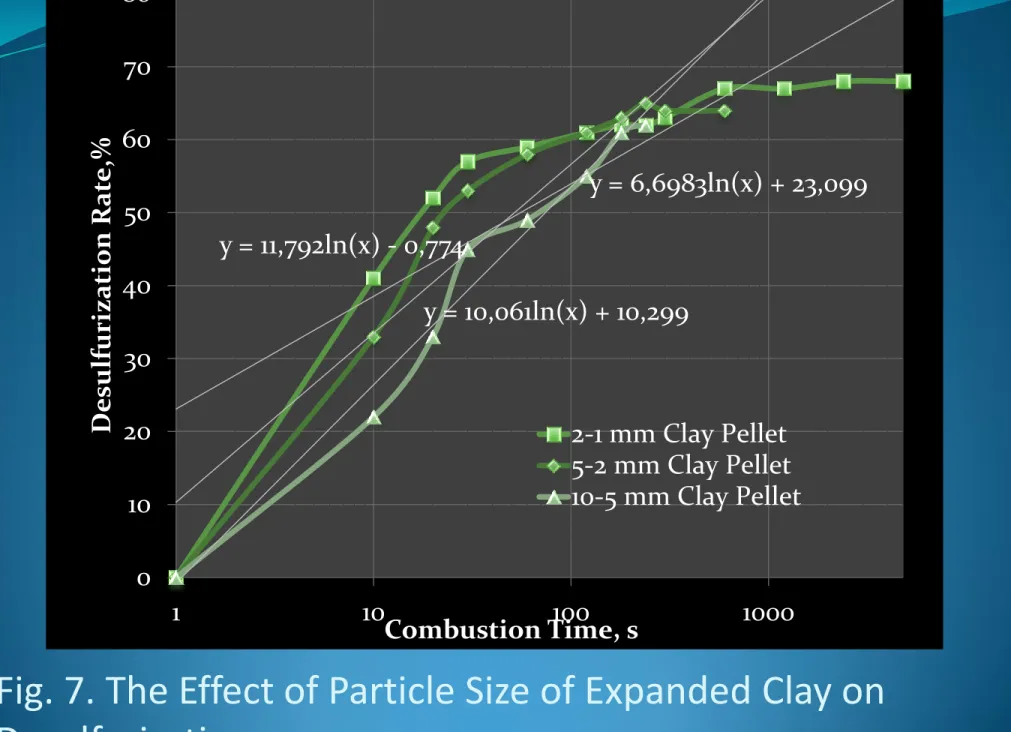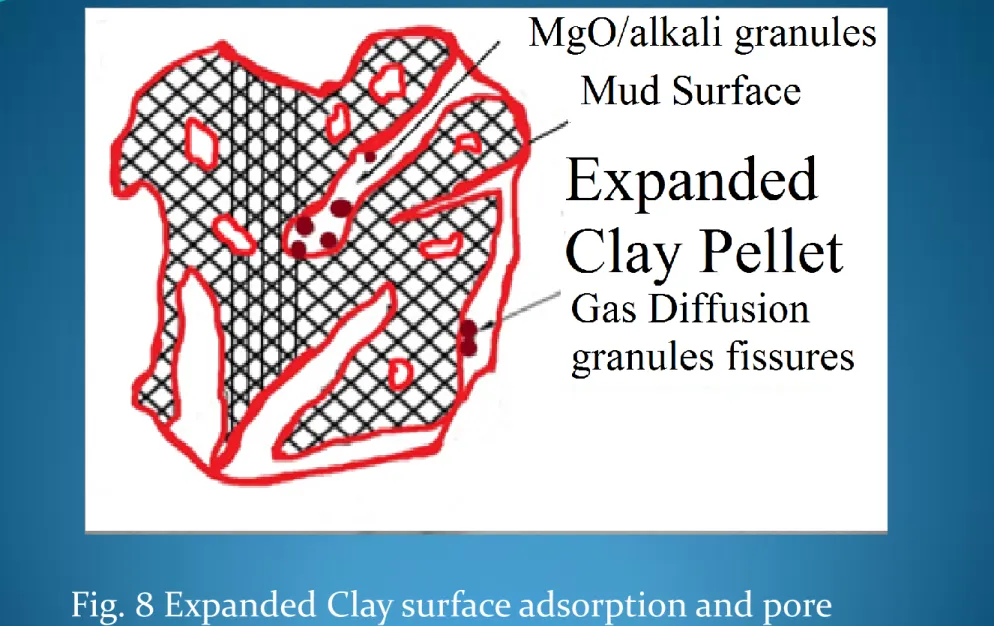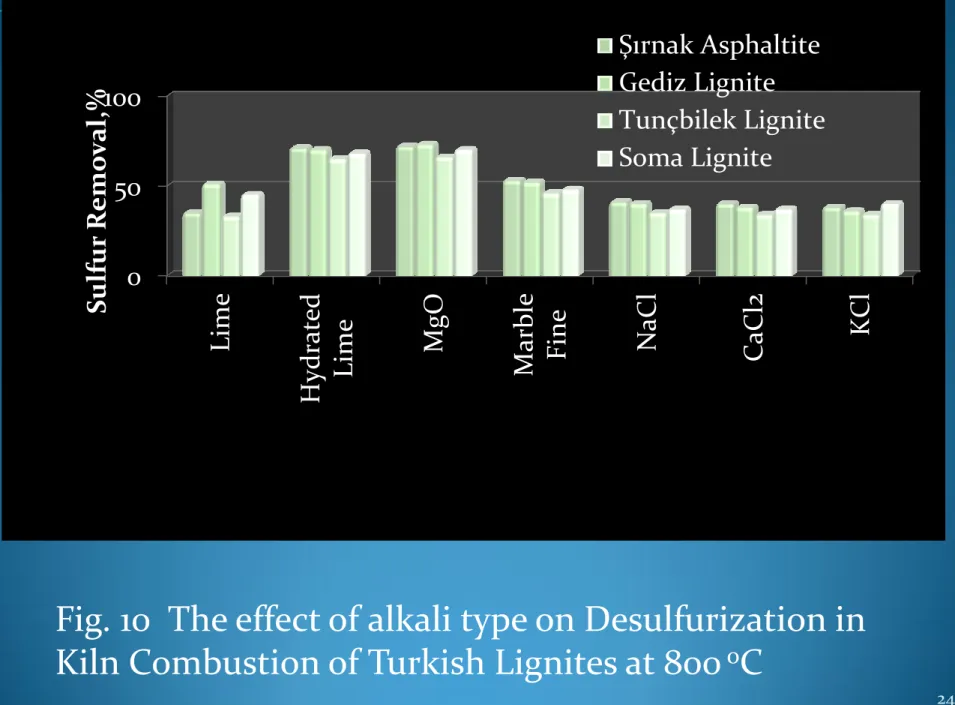Yıldırım İ. Tosun
Engineering Faculty, Şırnak University, Sırnak
*
Corresponding Author. Tel: +90(544) 5896824, Fax:
(486) 2164844, E-mail:
yildirimtosun@sirnak.edu.tr
Scope
This paper serves to describe the elimination of toxic gas emissions in coal combustion chambers and activity of expanded clay soaked MgO and other alkali materials such as Lime, Hydrated lime, NaCl, MgCl2 and KCl used in desulfurization. An chemical analysis of ash materials used to characterize the elimination of toxic substances was carried out. As well, the ability of the
expanded clay to remove inorganic and organic sulphur and other pollutant substances were determined with their respective process control challenges.
In this study, combustion tests of Şırnak asphaltite and different types of
Turkish lignites; Kütahya Gediz, Tunçbilek, Soma Kısrakdere were carried out. Lime, Hydrated lime, Magnesia, NaCl, MgCl2 and KCl were used as
desulfurizing solid sorbent. The different type of solid sorbents such as Şırnak limestone, marly limestone and claystone, MgO soaked expanded clay use in coal desulfurization were virtually investigated and discussed. Combustion of solid fuels in the presence of expanded clay was managed at low particle sized such as 1-2mm. Expanded clay was examined as an absorbent for a conversion of toxic gas to friendly emissions. It can be a promising waste incineration for the production of electricity from nylon and plastic contaminated municipal wastes because of high activity in the collection and leaching in the toxic gas in the combustion reaction.
Introduction
3
Coal, biomass or waste as a solid fuel, waste liquid fuels from natural
sources and biodiesel have gained more market due to its use in electricity. Combustion of coal, biomass or waste creates toxic gas emissions for
environmental concern. The electricity production of Turkey from the primary resources are naural gas iporte an coal as high as 22% (Figure 1)(TTK, 2009,TKİ, 2009, IEA 2014). Reasons for growing interest in toxic gas emission control include its potential for reducing noxious emissions. Uses of fuels as potential contributions to rural economic development reduce reliance on high quality fuels, as an additional demand centre for electricity commodities and as a way to urbanization (Demirbaş and Balat, 2004).
Desulfurization of coal has firstly applied for the flue gas in coke
production and in fluidized bed combustion systems with limestone addition into the coal combustion chamber. The pro-combustion desulfurization methods have significantly been developed by wet desulfurization units in thermal power stations. However, small scale operation of wet desulfurization plants may not be economic (Wheelock, 1979). Especially in waste incineration pro combustion emission control may cost higher prices such as 60-90$/ton. The expanded clay pellets soaked magnesia slurry may cost lower such as 3-5$/ton.
Fig. 1. The Revised Electricity Production from Turkish Primary
Resources and Renewable Comparison.(IEA 2014)
4 0 10 20 30 40 50 17,8 48,7 22,3 5,7 3,8 0,8 0,1 0,1 0,1 Pr odu ction,%
5
Conventional coal combustion systems using Stokers or grate chambers are not designed to treat potentially contaminated municipal organic waste in order to prevent by post combustion the potential spread of toxic emissions in coal and wastes (Tosun, 2013) and potantial problems related to organic matter, phenol, such as undesirable colour, odour formation(Hartikainenet al. 2001). Solid
adsorbents are needed in the combustion chamber systems typically consist of alkali salts intake, coagulation ash processes (Çulfaz et al. 1997, Tosun, 2007, Tosun, 2012).
Specifically, combustion temperature and secondary air may improve to destroy or impair unwanted emissions through chemical adsorption (Sharma et al.
2008).
The different type of chemical alkaline react with coal samples in combustion chamber at atmospheric pressure by the equations as given below (Kumar et al, 2000);
SiO2 + 2NaOH / Na2CO3 ® Na2SiO3 + H2O (1)
Al2O3 + 2NaOH / Na2CO3 ® Na2AlO2 + H2O (2)
6
Effective sorption in combustion processes depend on numerous factors including coal rank in carbonization, the volatile gaseous matter of coal such as presence of hydrogen, carbonyl gas and
oxidation rate so stabilizing the desorbance, the settings of optimal
diffusion conditions including structure defects (nitrogen, phosphorus, sulfur, etc.), temperature, oxygen content of coal, etc. and optimization of carbondioksit concentration ratios added the adsorption–desorption balance, the residence time and the spatial distribution of molecules in coal pores among other factors determining the efficiency of
carbonization. as factors affecting the rate and extent of carbonization much dependent on the site activation, its desorption properties and its porosity. As discussed in the previous section, carbonization is a prerequisite step for oil generation from biomass wastes and coal (Wheelock, 1979).
Factors affecting toxic gas
sorbtion in combustion
7
In this research, representative specimens of the Şırnak asphaltite and different types of Turkish lignites; Kütahya Gediz, Tunçbilek, Soma Kısrakdere were crushed and comminuted to minus 1mm size by
controlled screening. Air dried samples of 40-50 gr from each different coal types were prepared and sealed in nylon bags. The different type of solid sorbents such as Şırnak limestone, marly limestone and claystone were used in the combustion. The chemical analysis of the solid
sorbents are given in Table 1. The results of proximate and ultimate analyses of various Turkish coals used in the experiments are given in Table 2 and Table 2. The qualities of processed coal products are
ascertained by chemical and standard coal analysis of ASTM 3173-3177.
Table 1. The chemical analysis values of limestone, marl and claystone of
Şırnak province
.
8 % Sorbent Şırnak Limestone Sırnak Marly limestone Şırnak Marl Şırnak Claystone Expanded Clay soaked MgO SiO2 3,53 9,42 24,14 48,53 44,3 Al2O3 2,23 6,53 12,61 24,61 22,1 Fe2O3 0,59 4,48 7,34 7,59 6,5 CaO 49,48 39,23 29,18 9,48 7,4 MgO 2,20 2,28 4,68 3,28 9,28 K2O 0,41 0,53 3,32 2,51 2,51 Na2O 0,35 0,24 1,11 0,35 0,35 Ignition Loss 46,19 26,11 21,43 6,09 0,09 SO3 0,32 0,21 0,20 0,32Table 2. Proximate Analysis of Turkish Lignite and Asphaltite. (ADB:Air
dried base. DB:Dried base, DAB:Dried ashless base).
9
Coal Type Ash,%
ADB Moisture ,% ADB TotalS, % DB Volatile Matter,% DAB Şırnak Asphaltite 46.3 0.1 7.1 62.6 Tunçbilek Lignite 29.3 18.1 3.1 52.6 Kütahya Gediz 22.0 1.7 3.6 42.7 Soma Kısrakdere 13.8 14.0 2.2 40.4
Fig. 2. Photos and Bright Sections and Parts of Şırnak limestone,
marl, claystone
Film. Coal, Wood, waste pellet combustion.
12
Film. Coal, Wood, waste pellet combustion.
Fig. 3. Particle Size Distribution of Turkish High Sulfur Coals.
13 1 10 100 10 100 1000 10000 U ndersiz e, log%Particle Size, micron
Tunçbilek Lignite Soma Kısrakdere Kütahya Gediz Şırnak Asphaltite
Normal Size Distribution
Fig. 4. Particle Size Distribution of of Solid Sorbents of Şırnak
limestone, marly limestone, marl, claystone, expanded clay
14 1 10 100 1 10 100 1000 10000 U ndersiz e, log%
Particle Size, micron
Şırnak Marl Expanded Clay
Şırnak Marl Şırnak claystone
15
As seen from Figure 3, 80% of weights of samples were under
3 mm. The lignite samples were mainly distributed between
1mm and 3 mm size fractions. As seen from Figure 4, 80% of
weights of solid sorbents were under 2 mm.Two normal
distributions are seen from Figure 4 due to different
mechanical breakage manners of solid sorbents. Especially,
hardly crushed particle size fraction of sorbents was ranging
between 2 and 3 mm.
Combustion experiments were carried out in a benchmarked
laboratory type 1m kiln reactor put in the furnace at
atmospheric pressure at a temperature precision of ±5
oC as
Fig. 5. Use Coal Combustion Retort subjected to solid sorbent
17
Turkish lignites may not be destroyed by controlled crushing
and screening till reducing particle size of specimens to minus
10 mm. As seen from Figure 3, normal distribution of coal size
was determined as two different fractions and highly sufficient
in order to combustion and react with solid sorbents.
Toprak analizleri
METOD
18
Fig. 9. Expanded Clay MgO Soaked photo 500X,
a.prior to combustion at 800
oC
Fig. 9. Expanded Clay MgO Soaked photo 500X,
b.Combustion at 800
oC
20
Combustion tests were carried out under atmospheric pressure
at a constant time period of 3 hours previously determined
over 1-2 kg lignite samples. MgO soaked expanded clay were
made by calcination of Şırnak claystone at 800
oC and soaking
with MgO and SEM picture was illustrated in Figure 6.Total
solid sorbent weight was hold constant at a quarter of coal
weight. Various sorbents were used at 1/4 weight rate into to
coal samples. The effect of particle size of solid sorbents were
investigated over the combustion of Şırnak Asphaltite and
carried out well on emitted gas substance subjected to reaction
with expanded clay in combustion, as shown in Fig. 7.
Fig. 7. The Effect of Particle Size of Expanded Clay on
Desulfurization
21 y = 6,6983ln(x) + 23,099 y = 10,061ln(x) + 10,299 y = 11,792ln(x) - 0,774 0 10 20 30 40 50 60 70 80 1 10 100 1000 D esul furiza tion Rat e, % Combustion Time, s 2-1 mm Clay Pellet 5-2 mm Clay Pellet 10-5 mm Clay Pellet22
Fig. 8 Expanded Clay surface adsorption and pore
entrapment.
23
Although molecular gas diffusion is believed to be the primary
mass transport process in the combustion chamber, complex
convective gas emissions proliferated the alkali clusters below
1-2mm size and exothermic combustion reactions increased
toxic substances in the gas form, a relatively porous structure
of expanded clay interstitial spaces and cracks reduced over
5mm size. The combustion gases substances towards the
expanded clay surface through this surface alkali is primarily
accomplished by molecular diffusion across the micro cracks
and alkali clusters. A reduction in the size of combustion coal
also permited more clay substrate to diffuse through the
surface towards the expanded clay sites subsequently increase
adsorption as illustrated in Figure 8.
24
Fig. 10 The effect of alkali type on Desulfurization in
Kiln Combustion of Turkish Lignites at 800
oC
0 50 100 Lime Hydr at ed
Lime MgO Marble Fine NaCl CaCl
2 KC l Sul fur R emo v a l,% Şırnak Asphaltite Gediz Lignite Tunçbilek Lignite Soma Lignite
25 Fig. 11. The Combusti on rate of Turkish Coals with Expanded Clay %10MgO Soaked, Combusti on at 800oC y = 6,6983ln(x) + 23,099 y = 10,061ln(x) + 10,299 y = 11,792ln(x) - 0,774 y = 9,9601ln(x) + 13,863 0 10 20 30 40 50 60 70 80 1 10 100 1000 C omb us tion Rat e % Combustion Time, s 10mm Gediz Lignite 10mm Tunçbilek Lignite 10 mm Soma Lignite 10 mm Şırnak Asphaltitel
26 Fig. 12. The sulphur removal effect of Expanded Clay %10MgO Soaked, Combusti on Şırnak Asphaltite at 800oC y = 8,2234ln(x) + 20,971 y = 6,855ln(x) + 4,246 y = 5,875ln(x) + 4,7502 y = 1,0457ln(x) + 9,8066 0 10 20 30 40 50 60 70 80 1 10 100 1000 D esul furiza tion Rat e, % Combustion Time, s
1-2 mm Expanded Clay Pellet 1-2 mm Şırnak Limestone
1-2 mm Şırnak Marly Limestone 1-2 mm Şırnak Marl
27 Fig. 13. The combustion temperature on the Desulfurization removal of Expanded Clay %10MgO Soaked. y = -0,0009x2 + 1,2733x - 388,7 y = -0,0005x2 + 0,795x - 239,83 y = -1E-04x2 + 0,0505x + 79,134 y = -0,0002x2 + 0,1931x + 2,8246 0 10 20 30 40 50 60 70 80 90 100 700 750 800 850 900 950 1000 D esul furiza tion Rat e,% Combustion Temperature, oC Sırnak asphaltite Gediz lignite Tunçbilek lignite Soma Lignite
28
The gaseous reacted adsorbate then adsorbs to the sorbent in
an certain amount that is equal to the amount of previous
adsorbate that was partially degraded on the surface of the
expanded clay and removing aliphatic hydrocarbons and
phenols/chlorinated phenols, carbonyl toxins, along with
organic matter related odour substances.
In the combustion experiments, the experimental condition is
calculated on the basis of the ash composition in the ambient
state. So neither the contained water vapour nor the
Among various cheap alkali fines such as Lime, Hydrated lime, Magnesia, NaCl, MgCl2 and KCl , magnesia were found as efficient desulfurizing solid sorbent. 72-74% desulfurization rates with Şırnak asphaltite, Gediz and Soma lignite could be reached. This cheap alkali sorbent fines may be so feasible at the side of cost and sorbent production.The high amount of gaseous emmissions might be reduced instead of massive alkali sorbent use. Advanced coal washing of Turkish lignite may not be feasible. However, the combustion with solid expanded clay soaked alkali fine of Turkish lignites can be managed. The heavy metal and toxic emissions of soot, nitrogen oxides and sulfur oxides with expanded clay soaked MgO managed at high elimination rates ranging 72-74%.
The approach of combustion kinetics assumed basically that the process exponentially was developed itself, as seen in Figure 11 with all specific features. The elimination of emissions with expanded clay sorbent was a decisive factor for the path of the kinetics of combustion reactions of coal. Therefore a static model of coal combustion was developed at 10mm of coal nut size. Instead of fluid bed combustion, packed bed combustion of coarse size coals is highly governed by slow combustion reactions, sufficiently sorbtion of toxic gas.
The different type of solid sorbents such as Şırnak
limestone, marly limestone, marl and claystone, MgO
soaked expanded clay were used at 1-2 mm size in coal
combustion at 800
oC and the effect of the masive solid
sorbent type on elimination of tğxic gas emmissions were
investigated and the results were illustrated in Figure 12. In
comparison of use massive solid sorbents in combustion of
solid fuels with the presence of expanded clay it was found
that at low particle sized such as 1-2mm lower surface area
of massive solid sorbents reduced desulfurization rate. As
seen in Figure 12, the expanded clay soaked MgO examined
was more efficient as an absorbent for a conversion of toxic
gas to friendly emissions. It can be a promising waste
incineration for the production of electricity from nylon
and plastic contaminated municipal wastes because of high
activity in the collection and leaching in the toxic gas in the
combustion reaction. The desulfurization rates reached to
In the combustion experiments with addition expanded
clay soaked 10% MgO, reactor temperature changed
between 700
oC and 1000
oC. Products received from
combustion of lignite with solid sorbent at 1-2 mm size at a
quarter weight rate to coal following 3 hours combustion
were
subjected
to
analysis
for
sulfur
hold-up
determination. Test results of combustion by expanded clay
between 700
oC and 1000
oC were seen in Figure 13.
From the point of view of temperature effect
experimentation, the resulted ash and sorbents analysis
following combustion showed that increasing temperature
reaching 1000
oC in combustion kiln for biomass, lignite
and other coal samples were suddenly combusted the
volatile substance without reacting sorbent matter in the
kiln even in comparison with different sorbent evaluation
and so we may reduce the effect of ash sorption.
The higher desulfurization yields were provided in combustion tests with using the expanded clays with MgO soaked with high sulfur coals in the kiln apparatus at a quarter weight rate to coal.
Combustion of different types of Turkish lignite was successfully processed in terms of desulfurization and depeng on the volatile matter.
At higher rates of combustion of different types of Turkish lignite could be obtained from the tests using high combustion temperature of 1000oC. it has
been clearly determined that CO2 and steam much beneficial in elimination of toxic matter of different types of Turkish lignite. Şırnak asphaltites should be also desulfurized at high rate of 88 and 74% and high ash content reduced toxic gas emission in combustion.
Benefaction from high sulfur Turkish lignite in the various parametric combustion systems, in order to receive clean energy clean liquid and gaseous products must be managed in low temperature reactions with expanded clay soaked with MgO. It is also advised that the high amount of elimination of toxic gas will be managed at low combustion temperatures over 700 oC and
more environmental friendly gaseous emissions were provided by 1-2 mm sized expanded clay in comparison same sized limestone.
Nut sized coal below 10mm sized in retort combustion carried out for Turkish lignite and Şırnak asphaltite showed sufficient desulphurization rates at 800 oC and even other lignites showed similar trend.
In order to optimize the desulfurization rates of the coal combustion and for the elimination high rate of detoxification in waste inceneration process as given in Figure 13 the low 800 oC combustion was adviced at nut size solid fuel combustion and with finer particle size fractions of coal specimens, the reactor temperature should be optimized to lower combustion kinetics mixed with expanded clay soaked MgO at 10% weight rate. However, as seen in Figure 12 it was showed that desulfurization rate reduced lower than 42 and 37% level at the addition a quarter weight of Şırnak limestone and marly limestone in to the combustion, respectively. That soot remained in ash was among 3,8-5,6%. Therefore it was supposed that porous expanded clay layers, improved finer fill of porous clay layers with alkali and ash metal catalysts of Turkish lignite and even exhibited sufficient gas permeability in small particle size fractions.
